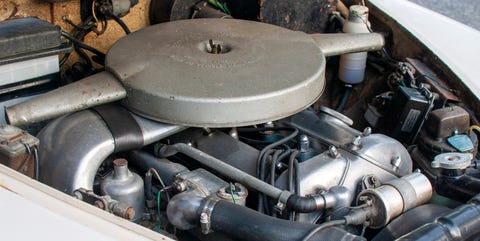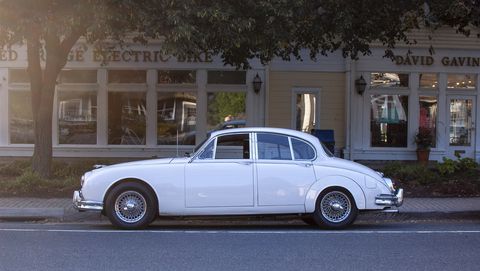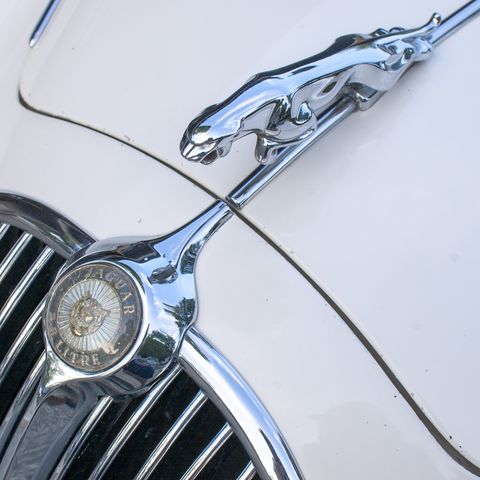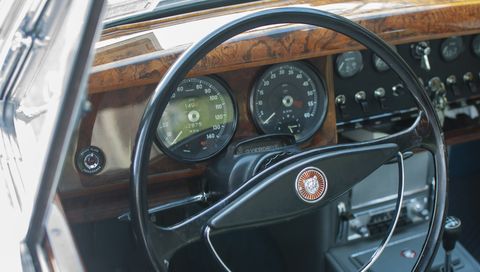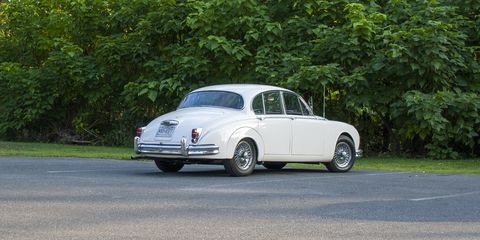It’s easy to see why the Jaguar Mark 2 became so beloved, regularly filling vintage racing grids, auction house lots, car show lawns, and top-10 lists of the greatest sports sedans of all time. This is the original, after all: a four-door with the power and poise to keep up with sports cars, plus luxury in abundance. In post-War Britain it was a revelation. It still is today.
Like many automakers in the Thirties and Forties, Jaguar was conscripted into supporting the War effort, but founder Sir William Lyons always had an eye on the future. The story goes that he and his engineers worked on a new straight-six during nighttime fire watches. This engine, the XK, debuted in 3.4-liter form with the XK120 sports car in 1948 and went on to power almost everything Jaguar made for the next three decades, including the Le Mans-winning C- and D-Types.
In the Fifties, riding high on its Le Mans victories, Jaguar wanted a new, entry-level sedan to complement its sports cars and its rather large Mk VII. The car would be of unibody construction, and while Jaguar considered making a four-cylinder adaptation of the XK engine, it wasn’t refined enough. Instead, Jaguar made a 2.4-liter version of its ‘six, and put it in a sedan creatively called the 2.4 Litre. That initial version debuted in 1955 and in 1957, a 3.4-liter version bolstered the lineup with the U.S. market in mind. In 1959, the 2.4 and 3.4 received new bodywork to improve visibility and a wider rear track. The new car, officially called the Mark 2—the original 2.4 and 3.4 gaining the Mark 1 retronym—also worked in four-wheel Dunlop disc brakes and crucially, an optional 3.8-liter engine.
All the ingredients were finally in place with the Mark 2 3.8, and they were executed to perfection. Jaguar’s slogan was “Grace, Space, Pace.” Few cars so successfully live up to their taglines. Everything about the car is elegant, from the way it looks, to the way it drives.
This white Mark 2 belongs to Road & Track contributor Jamie Kitman, who kindly lent it out for a late summer’s weekend. Kitman’s owned many eclectic European cars over the years, but he’s had this car longer than any other, 34 years, and he’s got no plan to sell. It’s a 1963 in the most desirable spec: 3.8-liter, four-speed overdrive manual.
I can’t imagine what this car felt like in its day. The archetypal family “saloon” of the late Fifties/early Sixties was the Morris Minor, which offered just 37 horsepower from its 1000cc four-cylinder; the Mark 2 3.8 claimed 220. Certainly, the Mark 2 wasn’t the only car putting out that kind of figure. American family cars of the era had similar power, but they were tail-finned boats; the Mark 2 coupled its performance with sports-car-esque handling.
Driving a Mark 2 is a little tricky at first, coming from a modern car. The four-speed is the infamous Moss gearbox, which wasn’t good by the standards of the day, and hasn’t gotten better in the intervening decades. While 2nd, 3rd, and 4th are synchronized, you still have to shift with patience. Double-clutching on the way up helps, while a good throttle blip is needed on the way down, and at a stop, you must go clutch-out in neutral before you even attempt to put it into first gear. It’s not an elegant experience. The steering is non-power, and thus brutally heavy, too, so just getting going from a stop in the Mark 2 is a chore. (An automatic and power steering were available, but no doubt spoiled the sporting character of the Mark 2.) Once you’re moving, it’s far better behaved, and the electronic overdrive makes a welcome addition.
I’m always amazed at how much an XK straight-six feels like an American V-8, doling out impressive low- and mid-range torque—its 240 lb-ft peak comes at 3000 rpm—but dying out before you hit the 5500-rpm redline. It’s a pretty stark contrast to how we think straight-six engines are going to act. BMW’s, for instance, thrive on revs, and there’s a good reason. All through its classic era BMW long favored oversquare engines—bore bigger than stroke. (These days, it uses very slightly undersquare engines.) From 1921 to 1948, cars in England were taxed by bore, so to compensate, stroke lengths got very long, and this trend continued long after this particular law was changed. To call the XK “lazy” would be misrepresenting things, but this thing does its best work up to around 4500 rpm. When in motion, you hardly ever need to go into second gear, such is the torque of the engine.
That 220-hp figure, it’s worth mentioning, is the old “gross” figure, likely measured with an engine sans accessories on the test bench. A 1959 3.8 tipped our scales at 3400 pounds. So the power-to-weight figure is hardly astonishing now, but that only makes it all the more surprising how this car can keep up with modern traffic.
It all comes down to how the Mark 2 handles. There’s a road leading to Lime Rock Park that, if a good bit wider, quite resembles a British B-road. It’s pretty heavily crowned, fast, and bumpy in parts, twisting gracefully through the countryside. How the Mark 2 hustled down that road left me astonished. Only when I drove the other way in traffic–seeing how slowly even brand-new cars take the turns–did I realize just how fast I’d driven the Jag earlier. It’s astounding that a 60-year-old car can do this. Some bigger bumps make obvious the fact that this car has a live rear axle, and there’s only so much grip from a set of narrow, old-school tires. Yet on the right road, the Mark 2 is still capable of doling out tons of pace, along with its space and grace. Thankfully, the disc brakes are up to the task. They feel quite ordinary by modern standards; they must’ve felt otherworldly when this car was new.
Even when you’re not on it, the Mark 2 continues to delight. The leather- and walnut-trimmed interior is sumptuous, the “cigar,” not “cigarette” lighter telling you everything you need to know about the vibe Jaguar was going for here. You attract the right kind of attention, too. People smile at what appears to be a stately cruiser, and they’re not necessarily wrong judging the Mark 2 as such. They just don’t know what it can do on a quiet road when no one’s looking.
The first Mark 2 we ever tested carried an MSRP of $4795—about twice as much as a contemporary Ford Galaxie, but among European cars, the Jaguar represented something of a bargain. A Mercedes 220SE cost over $1000 more and offered far less performance. That first 3.8 test car had some quality issues, and many of our readers reported the same of their Jaguars, so, uh, you got what you paid for? However, quality issues didn’t stop the Mark 2 from becoming Jaguar’s best seller in its day. Nothing at the time offered quite the same performance, practicality, and luxury.
Coming away from the Mark 2, I had a surprising question: Why didn’t anyone figure this out sooner? I wasn’t thinking, “Wow, it’s amazing how much Jaguar got right 60 years ago,” but instead, “it took decades of auto making to arrive on what now seems like the most basic of recipes?”
The Mark 2 remains relevant to this day because the recipe hasn’t really changed. Only the execution. Big powerful engine in the front, comfy interior, excellent rear-drive chassis. BMW got credit for inventing the super sedan with the original M5 of 1984, but how was it not just following the basic template Jaguar set?
In its details, the Mark 2 feels decidedly old-school, but think big picture here—it’s not that different from modern sports sedans. Jaguar had the right idea here. An idea that transcended the whole company.
